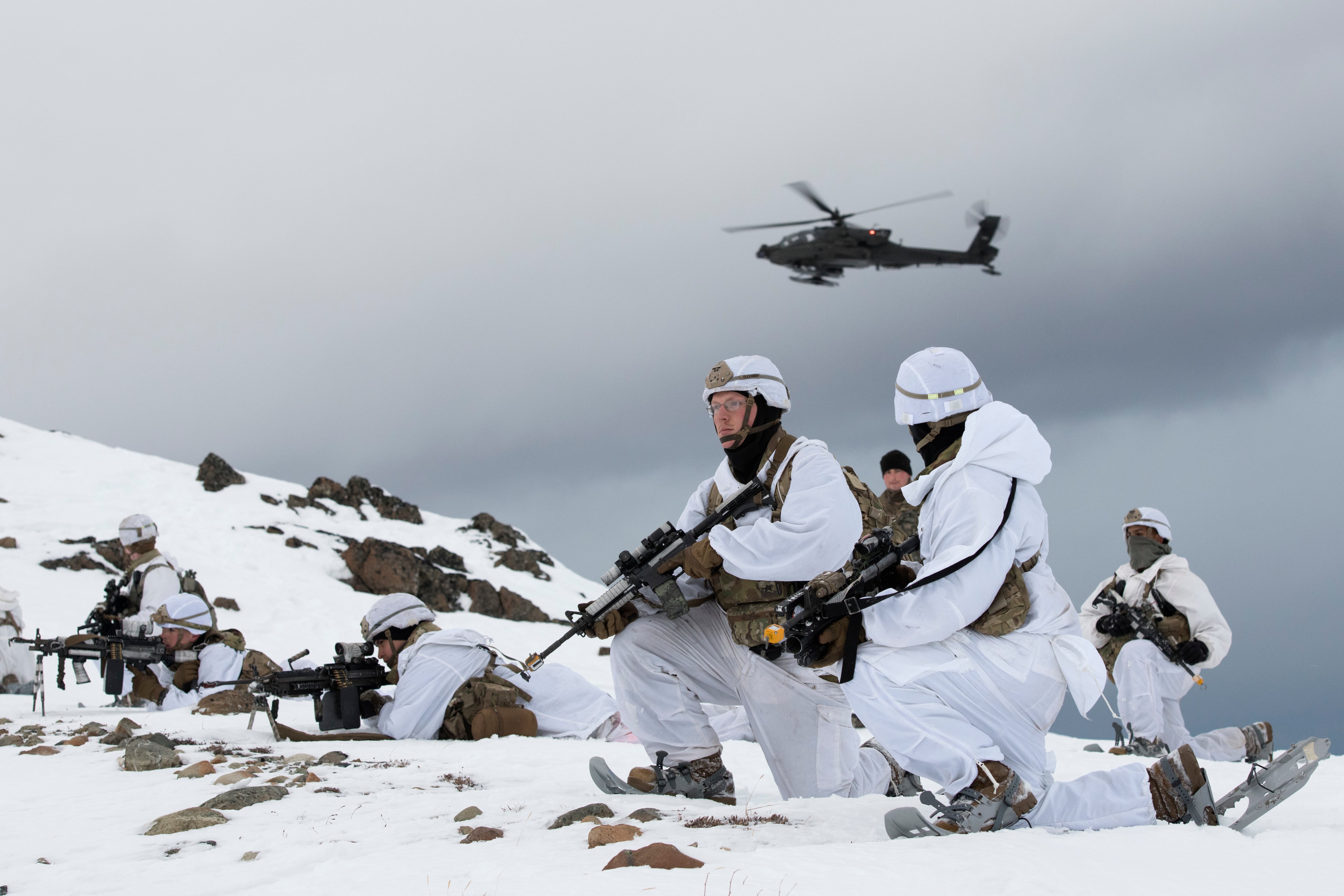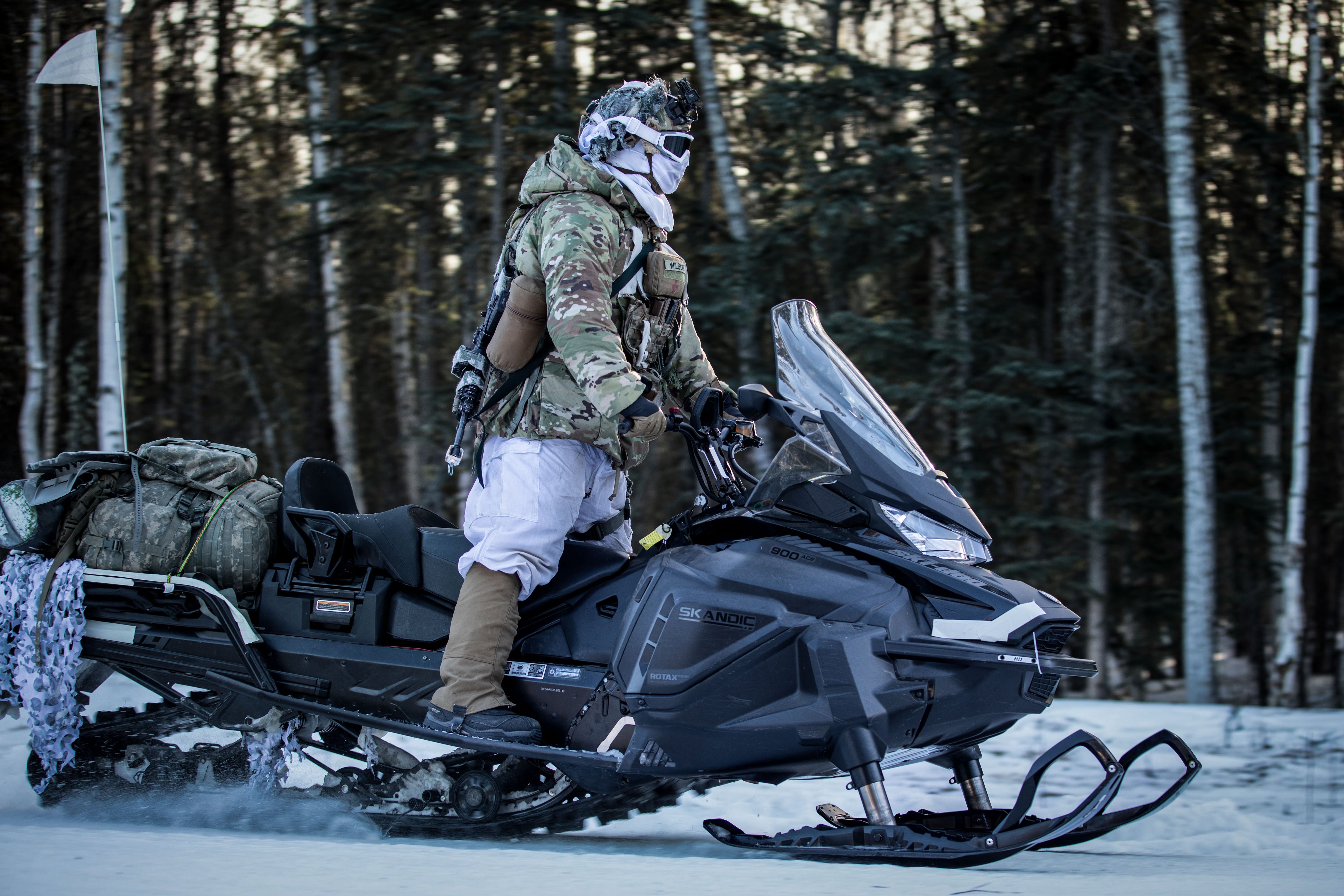More than 8,000 soldiers in Alaska recently concluded a large-scale exercise that included a 150-mile helicopter deep strike, flying a rocket launcher 500 miles to operate above the Arctic Circle and snowmobile hunter-killer teams armed with shoulder-fired rockets.
Maj. Gen. Brian Eifler, commander of the Alaska-based 11th Airborne Division, spoke with reporters Monday about the Joint Pacific Multinational Readiness Center training exercise that took place from Feb. 8 through Feb. 22 across the state.
It’s been three years since the Army started its Joint Pacific Multinational Readiness Center rotations in Alaska, and Eifler said this was the largest and most complex version of the training so far.
A Mongolian Armed Forces infantry company and 600 Canadian troops, 350 from the 3rd Battalion, Princess Patricia’s Canadian Light Infantry, 165 from the Royal Canadian Air Force and 100 from various support forces, participated alongside U.S. forces. Other partner nations such as Sweden, Finland and South Korea sent forces to work with staff sections of U.S. units.
Another 18 nations sent observers to the exercise, Eifler said of the growing exercise.
RELATED

The Army released its Arctic Strategy in 2021. In June 2022, the service reactivated the 11th Airborne Division in Alaska to oversee and grow Arctic-focused forces and training to counter increasing militarization of the region by Russian and Chinese military forces.
The 1st Brigade, 11th Airborne Division, served as the “blue force” fighting over the two weeks against two battalions of the 2nd Brigade, 11th Airborne Division, which served as the enemy force.
Both units ran their field operations but were joined by simulated brigades. Eifler and his team were able to fight an entire division in the exercise using simulated forces alongside real soldiers, he said.
The 2nd Brigade was given about five times the number of rockets, artillery and ammunition to battle 1st Brigade. The “enemy” brigade also had air defense, communication jamming and electronic warfare tools.
That extra firepower meant that blue force fire units had to pick their targets wisely, shoot quickly and move rapidly to avoid enemy counterfires, Eifler said.
The enemy air defense challenged the blue force to create attack windows and push realistic approaches to a near-peer adversary that controlled the sky.
A standard airborne or air assault mission would easily be detected in that scenario, he said. Which meant division aviators had to strike first.
“We did a 150-mile deep attach with our Apache division while avoiding air defense emitters that we put out,” Eifler said. “They had to duck and weave over those 150 miles close to the terrain to get to the target and destroy it and get back safely.”
Deep strike
That was the first and longest such deep strike of that distance since the rotations began, Eifler said.
Once the strike had its effect, the blue force brigade flew a more than 80-mile air assault using 15 aircraft, including Chinooks and Black Hawks, he said.
On the ground, soldiers used the five new cold-weather, all-terrain vehicles, or CATV, during the exercise, which Eifler said performed well and allowed soldiers to maneuver over various snow, mud and water-logged terrain. Temperatures fluctuated from -40 degrees Fahrenheit to 40 F
BAE Systems won the $278 million contract to produce the cold-weather, all-terrain vehicle for the Army in 2022. At the time the service planned to purchase 163 of them to replace its decades-old small unit support vehicle.
The cold-weather, all-terrain vehicle is a tracked vehicle that can carry nine soldiers and equipment.

At the same time, 1st Brigade dispatched soldier teams on snowmobiles armed with Javelin missile launchers to navigate off-road and knock out enemy tanks and vehicles.
“One of our standing orders is to stay off the road when you’re fighting in harsh weather because the roads and trails are like the enemy’s engagement areas,” Eifler said. “We’re always saying ‘if your traveling is easy, you’re running into danger. And if it’s very hard and difficult to move you’re winning.’”
In the airwaves, the enemy force jammed digital communications that, at times, forced commanders to dispatch those same CATVs and snowmobiles to hand-deliver orders to battalions and other units.
The unforgiving cold
Eifler stressed that soldiers operating in the Arctic need to simultaneously keep their high-tech gear running but be ready to go “manual or mechanical” to get the job done.
The unforgiving cold can paralyze some systems and drain batteries in minutes, not hours.
As part of the exercise, soldiers used a C-130 cargo plane to fly a high mobility artillery rocket system more than 500 miles to Utqiagvik, Alaska ― a city on the northernmost reaches of the state and above the Arctic Circle.
Eifler’s blue force also had to contend with smaller, but still challenging threats.
The enemy force used small drone swarms of a dozen or fewer drones used to detect unit positions. They even “armed” some of the small drones with tennis balls and Nerf footballs to drop onto locations, showing soldiers they could be hit by ordnance they weren’t tracking.
During the two-week exercise, Eifler said soldiers tested 40 different types of equipment, from communications gear and vehicles to tents, skis and boots.
The two-star said that in the future the force likely will need more snowmobiles for the types of missions used in this exercise as well as casualty evacuation and basic mobility.
Early observations include a need for a better tent system that can fit into a rucksack and improved ski bindings to withstand the extreme cold temperatures, he said.
Todd South has written about crime, courts, government and the military for multiple publications since 2004 and was named a 2014 Pulitzer finalist for a co-written project on witness intimidation. Todd is a Marine veteran of the Iraq War.




